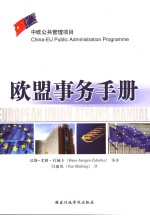

欧盟事务手册PDF电子书下载
- 电子书积分:10 积分如何计算积分?
- 作 者:扎赫卡编著;闫淑凤译
- 出 版 社:北京:国家行政学院出版社
- 出版年份:2006
- ISBN:7801405552
- 页数:205 页
欧盟 1
1.1 历史 1
1.2 再次扩大与睦邻政策 7
1.3 欧盟宪法(2004年6月18日鉴署) 9
1.4 欧盟“超大型项目系列” 11
1.5 未来几年欧盟议程 14
1.6 欧盟:从北至南,从西至东 16
1.6.1 欧盟版图 16
1.6.2 欧盟的语言问题 16
1.7 1950年5月9日罗伯特·舒曼的演讲 20
1.8 欧盟的象征 25
1.8.1 5月9日:欧洲日 25
1.8.2 欧盟盟旗 25
1.8.3 欧盟盟歌 27
欧盟机构 28
2.1 欧盟机构的结构和任务 28
2.1.1 欧盟委员会 28
2.1.2 欧盟理事会 29
2.1.3 欧洲议会 31
2.1.4 欧洲法院 32
2.1.5 其他机构 32
2.2 机构及透明度 33
公共经济 36
3.1 欧盟单一市场及其功能 36
3.1.1 单一市场的原因及结果 36
3.1.2 愿景:创建“欧洲内部市场” 40
3.2 欧洲经济区(EEA) 41
3.3 内部市场中欧盟与中国的关系 42
3.4 “四个自由”:在欧盟内商品、服务、资本和人员的自由流动 43
3.4.1 人员自由流动 43
3.4.2 商品的自由流动 46
3.4.3 服务的自由流动和机构的自由设立 51
3.4.4 资本的自由流动 53
3.5 公共采购 54
3.6 公私伙伴关系(PPP) 55
3.7 环境与社会保障政策的可持续性 56
4.欧洲货币联盟(EMU) 61
4.1 历史 61
4.2 实现欧洲货币联盟 62
4.2.1 实现欧洲货币联盟的三个阶段 62
4.2.2 趋同标准 63
4.2.3 欧元区 64
4.2.4 其他国家和地区 65
4.3 为什么建立欧洲货币联盟? 66
4.4 欧元 66
4.4.1 欧元符号 66
4.4.2 汇率 67
4.4.3 欧元钞票与硬币 68
4.5 欧洲中央银行及其他机构 69
4.6 欧元在世界体系中 71
4.6.1 欧元的国际作用 71
4.6.2 对中国制造商、出口商和进口商的影响 72
信息技术与应用 74
5.1 总论 74
5.2 活动 75
5.2.1 电子欧洲 75
5.2.2 “i2010”(2010年欧洲信息社会) 76
5.2.3 电子内容 76
5.3 电子政务 77
5.3.1 公共上网点(PIAP's) 77
5.3.2 电子签名和互联网安全——保证公共部门信息交流安全 78
5.3.3 电子公共采购 80
5.3.4 电子欧洲奖 83
5.3.5 电子政务良好实践框架 83
The European Union 87
1.1 History 87
1.2 Next enlargements and Neighbourhood Policy 95
1.3 EU Constitution(adopted on 18th June 2004) 98
1.4 EU"Mega Project Cycles" 100
1.5 An Agenda for the EU in the next years 105
1.6 The European Union from North to South and West to East 107
1.6.1 Map of the European Union 107
1.6.2 Language Problem in the EU 108
1.7 The Robert Schuman Speech from 9th May 1950 112
1.8 The Symbols of the European Union 120
1.8.1 May 9th:Europe Day 120
1.8.2 The flag of the European Union 121
1.8.3 The European Anthem 123
The EU Institutions 125
2.1 Structure and Tasks of the EU Institutions 125
2.1.1 European Commission 125
2.1.2 Council of the European Union 127
2.1.3 European Parliament 129
2.1.4 European Court of Justice 130
2.1.5 Other institutions 131
2.2 Institutions and Transparency 132
Public Economies 136
3.1 EU Single Market and its functions 136
3.1.1 Reasons and Consequences of the Single Market 136
3.1.2 Vision:Creation of a"European home market" 142
3.2 European Economic Area(EEA) 143
3.3 EU-China aspects of the Internal Market 145
3.4 "Four Freedoms":free circulation within the EU for goods,services,capital and persons 146
3.4.1 Free movement of persons 146
3.4.2 Free movement of goods 149
3.4.3 Free movement of services & establishment 156
3.4.4 Free movement of capital 159
3.5 Public Procurement 160
3.6 Public Private Partnerships(PPP) 162
3.7 Sustainability in Environment and Social Policy 163
4.The European Monetary Union(EMU) 171
4.1 History 171
4.2 Achieving EMU 173
4.2.1 Three Stages for Achieving the EMU 173
4.2.2 The Convergence Criteria 174
4.2.3 The"euro area" 175
4.2.4 Other countries and regions 176
4.3 Why the European Monetary Union? 177
4.4 The Euro 178
4.4.1 The Euro Symbol 178
4.4.2 Conversion rates 179
4.4.3 Euro banknotes and coins 180
4.5 The European Central Bank and other Institutions 182
4.6 The Euro in the world 185
4.6.1 The international role of the Euro 185
4.6.2 Consequences for Chinese producers,exporters and importers 186
Information Technology and Application 189
5.1 General 189
5.2 Activities 190
5.2.1 eEurope 190
5.2.2 "i2010"(European Information Society in 2010) 191
5.2.3 eContent 192
5.3 eGovernment 192
5.3.1 Public Internet Access Points(PIAP's) 193
5.3.2 Electronic Signature and Internet Security-Secure communications between public services 194
5.3.3 Electronic Public Procurement 197
5.3.4 eEurope Awards 200
5.3.5 eGovernment Good Practice Framework 201
- 《Maya 2018完全实战技术手册》来阳编著 2019
- 《高等教育双机械基础课程系列教材 高等学校教材 机械设计课程设计手册 第5版》吴宗泽,罗圣国,高志,李威 2018
- 《慢性呼吸系统疾病物理治疗工作手册》(荷)瑞克·考斯林克(RikGosselink) 2020
- 《战略情报 情报人员、管理者和用户手册》(澳)唐·麦克道尔(Don McDowell)著 2019
- 《实用内科手册》黄清,阮浩航主编 2016
- 《基层医疗卫生机构安全用药手册》黎月玲,熊慧瑜 2019
- 《同仁眼科手册系列 同仁儿童眼病手册》付晶编 2018
- 《环境噪声监测实用手册》中国环境监测总站编 2018
- 《高度关注物质(SVHC)毒性手册 上》顾爱华主编 2019
- 《吉他宝典 吉他手超级手册 上》姜伟主编;汶麟,姚林,杜新春,赖康康,朱家明,克尔曼副主编 2018
- 《市政工程基础》杨岚编著 2009
- 《家畜百宝 猪、牛、羊、鸡的综合利用》山西省商业厅组织技术处编著 1959
- 《《道德经》200句》崇贤书院编著 2018
- 《高级英语阅读与听说教程》刘秀梅编著 2019
- 《计算机网络与通信基础》谢雨飞,田启川编著 2019
- 《看图自学吉他弹唱教程》陈飞编著 2019
- 《法语词汇认知联想记忆法》刘莲编著 2020
- 《培智学校义务教育实验教科书教师教学用书 生活适应 二年级 上》人民教育出版社,课程教材研究所,特殊教育课程教材研究中心编著 2019
- 《国家社科基金项目申报规范 技巧与案例 第3版 2020》文传浩,夏宇编著 2019
- 《流体力学》张扬军,彭杰,诸葛伟林编著 2019
- 《国家社科基金项目申报规范 技巧与案例 第3版 2020》文传浩,夏宇编著 2019
- 《情报学 服务国家安全与发展的现代情报理论》赵冰峰著 2018
- 《指向核心素养 北京十一学校名师教学设计 英语 七年级 上 配人教版》周志英总主编 2019
- 《行政保留研究》门中敬著 2019
- 《北京生态环境保护》《北京环境保护丛书》编委会编著 2018
- 《21世纪法学系列教材 配套辅导用书 行政法与行政诉讼法练习题集 第5版》李元起主编 2018
- 《国家执业药师考试历年真题试卷全解 2015-2019 中药学专业知识 1》黄坤主编 2020
- 《复旦大学新闻学院教授学术丛书 新闻实务随想录》刘海贵 2019
- 《2019国家医师资格考试用书 中医执业助理医师资格考试全真模拟试卷与解析 第3版》国家医师资格考试研究组 2019
- 《指向核心素养 北京十一学校名师教学设计 英语 九年级 上 配人教版》周志英总主编 2019
